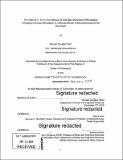The role of IL-17a in the rescue of ASD-like behavioral phenotypes following immune stimulation in a mouse model of neurodevelopmental disorders
Author(s)
Reed, Michael Douglas.
Download1280901891-MIT.pdf (25.27Mb)
Other Contributors
Massachusetts Institute of Technology. Department of Brain and Cognitive Sciences.
Terms of use
Metadata
Show full item recordAbstract
A subset of children with autism spectrum disorder (ASD) exhibit temporary but significant improvement of their behavioral symptoms during episodes of fever. Fever is an increase body temperature that is typically the product of the immune response mounted in order to fight infection. Investigation into the curious connection between fever and the manifestation of ASD behavioral phenotypes is at its infancy and therefore the mechanisms underlying this phenomenon are unknown. Here, we attempt to understand the neural and molecular mechanisms mediating this connection. The etiology of ASD is heterogeneous and is composed of both environmental and genetic risk factors. Therefore, we compared an environmental model of neurodevelopmental disorders in which mice were exposed to maternal immune activation (MIA) during embryogenesis with mice genetically deficient for Cntnap2, Fmr1, and Shank3. We found that activation of the immune system using lipopolysaccharide (LPS) was sufficient to rescue behavioral deficits within the MIA model, but not the monogenic mutant model mice. Behavioral rescue was correlated with reduced hyperactivation in the primary somatosensory cortex dysgranular zone (S1DZ), a region that has been previously shown to be tightly linked to MIA behavioral phenotypes. Consistent with the selective effects of LPS within MIA offspring, this reduction in hyperactivation was unique to MIA offspring. Differences in response to LPS could be explained by reduced IL-17a induction in monogenic mutant mice compared with MIA offspring. Circumventing this difference by directly administering IL-17a into the brain was sufficient to promote sociability in MIA offspring as well as monogenic mutant mice. IL-17a signaling is shown to be critical for the LPS-induced behavioral rescue and reduction in hyperactivity. Genetic removal of its cognate receptor, IL-17Ra selectively within the S1DZ, similarly prevented the ability of LPS to rescue MIA sociability deficits. These data support a model in which IL-17a signaling within the S1DZ mediates the behavioral and neurophysiological effects of immune activation in the MIA model.
Description
Thesis: Ph. D., Massachusetts Institute of Technology, Department of Brain and Cognitive Sciences, February, 2020 Manuscript. Vita. Includes bibliographical references.
Date issued
2020Department
Massachusetts Institute of Technology. Department of Brain and Cognitive SciencesPublisher
Massachusetts Institute of Technology
Keywords
Brain and Cognitive Sciences.